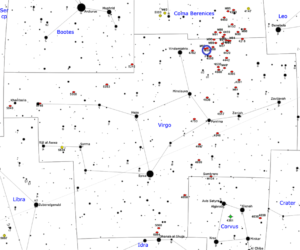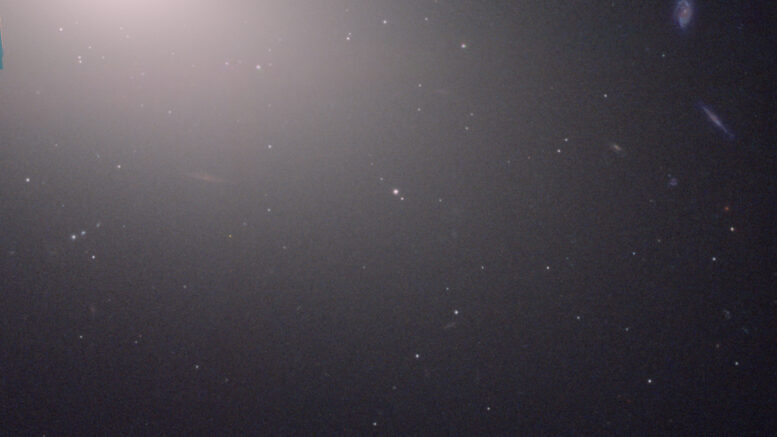Messier 59 is an elliptical galaxy located in the southern constellation Virgo.
| Description | |
| Visible From Pacific Northwest | Later Night January to Early Nights June |
| Best Time To Observe | March and April |
| Minimum Size Of Viewing Device | Larger Telescope |
| Object Type | Elliptical Galaxy |
| Designations | Messier 59, M59, NGC 4621, PGC 42628, UGC 7858, GC 3155, VCC 1903, Z 1239.5+1155, 2E 1239.5+1155, MCG+02-32-183 |
| Right Ascension | 12h 42m 02.3s |
| Declination | +11°38’49” |
| Constellation | Virgo |
| Number Of Stars | 200 Billion |
| Apparent magnitude | +10.6 |
| Apparent dimensions | 5′.4 x 3′.7 |
| Object Radius | 90,000 light years |
| Distance From Earth | 60 million light years |
History
Messier 59 and its close neighbour Messier 60 were discovered by the German astronomer Johann Gottfried Koehler on April 11, 1779. Koehler described the pair as “two very small nebulae, hardly visible in a 3-foot telescope: The one above the other.”
Charles Messier added the two elliptical galaxies together with the nearby Messier 58 to his catalogue a few days after Koehler’s discovery, on April 15. He described M59 as a “nebula in Virgo & in the neighborhood of the preceding [Messier 58], on the parallel of epsilon [Virginis], which has served for its [position] determination: it is of the same light as the above, equally faint. M. Messier reported it on the Chart of the Comet of 1779.”
John Herschel catalogued the object as h 1386, describing it as “bright; irregularly round; mottled.” He later added it to the General Catalogue as GC 3155, noting that it was “bright; pretty large; little extended; very suddenly very much brighter toward the middle; 2 stars preceding [westward].”
A supernova was detected in the galaxy in 1939. Designated SN 1939B, the supernova reached a peak magnitude of 11.9.
Locating M59 In The Sky
Messier 59 can be found in the region of the sky between the bright stars Vindemiatrix in Virgo and Denebola in Leo. Going 4.5 degrees west and a bit north from Vindemiatrix, one can find the giant elliptical galaxy Messier 60 and its fainter companion NGC 4647. M59 lies a bit further to the west of M60.

Viewing M59
Messier 59 is best seen in larger telescopes. Smaller instruments will only reveal a small elliptical patch with a brighter core. The central region of M59 is clearer in medium-sized and large telescopes, but even larger instruments do not reveal much detail. The best time of year to observe M59 is during the spring.
Photographing M59
Although Messier 59 is not necessarily that interesting to image, there are dozens of other galaxies visible in the same frame as elliptical galaxy. An amazing spring galaxy, Messier 59 will require several hours of imaging with accurate autoguiding. There are a plethora of options for use, which have been blogged by several astrophotographers and astrobin can provide a great option for viewing how others with similar gear have handled imaging M59.
https://www.galactic-hunter.com/post/m59-m60
https://www.cloudynights.com/topic/548800-m-59-and-friends/
Sources And Further Reading
Descriptions of all of Messier Objects can be found here.
https://www.nasa.gov/feature/goddard/2018/messier-59
https://www.messier.seds.org/m/m059.html
https://freestarcharts.com/messier-59

Be the first to comment on "Messier 59"